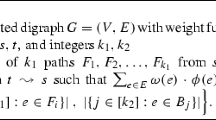Abstract
Consider an undirected graph G = (VG, EG) and a set of six terminals T = {s 1, s 2, s 3, t 1, t 2, t 3} ⊆ VG. The goal is to find a collection \(\mathcal{P}\) of three edge-disjoint paths P 1, P 2, and P 3, where P i connects nodes s i and t i (i = 1, 2, 3).
Results obtained by Robertson and Seymour by graph minor techniques imply a polynomial time solvability of this problem. The time bound of their algorithm is O(m 3) (hereinafter we assume n : = |VG|, m : = |EG|, n = O(m)).
In this paper we consider a special, Eulerian case of G and T. Namely, construct the demand graph H = (VG, {s 1 t 1, s 2 t 2, s 3 t 3}). The edges of H correspond to the desired paths in \(\mathcal{P}\). In the Eulerian case the degrees of all nodes in the (multi-) graph G + H (= (VG, EG ∪ EH)) are even.
Schrijver showed that, under the assumption of Eulerianess, cut conditions provide a criterion for the existence of \(\mathcal{P}\). This, in particular, implies that checking for existence of \(\mathcal{P}\) can be done in O(m) time. Our result is a combinatorial O(m)-time algorithm that constructs \(\mathcal{P}\) (if the latter exists).
Preview
Unable to display preview. Download preview PDF.
Similar content being viewed by others
References
Cormen, T., Stein, C., Rivest, R., Leiserson, C.: Introduction to Algorithms. McGraw-Hill Higher Education, New York (2001)
Ford, L., Fulkerson, D.: Flows in Networks. Princeton University Press, Princeton (1962)
Marx, D.: Eulerian Disjoint Paths Problem in Grid Graphs is NP-Complete. Discrete Applied Mathematics 143, 336–341 (2004)
Robertson, N., Seymour, P.D.: Graph Minors XIII. The Disjoint Paths Problem. Journal of Combinatorial Theory (Series B) 63, 65–110 (1995)
Schrijver, A.: Combinatorial Optimization. Springer, Berlin (2003)
Shiloach, Y.: A Polynomial Solution to the Undirected Two Paths Problem. J. ACM 27(3), 445–456 (1980)
Shiloach, Y., Perl, Y.: Finding Two Disjoint Paths between Two Pairs of Vertices in a Graph. J. ACM 25(1), 1–9 (1978)
Tholey, T.: Solving the 2-Disjoint Paths Problem in Nearly Linear Time. In: Diekert, V., Habib, M. (eds.) STACS 2004. LNCS, vol. 2996, pp. 350–361. Springer, Heidelberg (2004)
Tholey, T.: Improved Algorithms for the 2-Vertex Disjoint Paths Problem. In: Nielsen, M., Kucera, A., Miltersen, P.B., Palamidessi, C., Tuma, P., Valencia, F.D. (eds.) SOFSEM 2009. LNCS, vol. 5404, pp. 546–557. Springer, Heidelberg (2009)
Author information
Authors and Affiliations
Editor information
Editors and Affiliations
Rights and permissions
Copyright information
© 2010 Springer-Verlag Berlin Heidelberg
About this paper
Cite this paper
Babenko, M.A., Kolesnichenko, I.I., Razenshteyn, I.P. (2010). A Linear Time Algorithm for Finding Three Edge-Disjoint Paths in Eulerian Networks. In: van Leeuwen, J., Muscholl, A., Peleg, D., Pokorný, J., Rumpe, B. (eds) SOFSEM 2010: Theory and Practice of Computer Science. SOFSEM 2010. Lecture Notes in Computer Science, vol 5901. Springer, Berlin, Heidelberg. https://doi.org/10.1007/978-3-642-11266-9_14
Download citation
DOI: https://doi.org/10.1007/978-3-642-11266-9_14
Publisher Name: Springer, Berlin, Heidelberg
Print ISBN: 978-3-642-11265-2
Online ISBN: 978-3-642-11266-9
eBook Packages: Computer ScienceComputer Science (R0)




